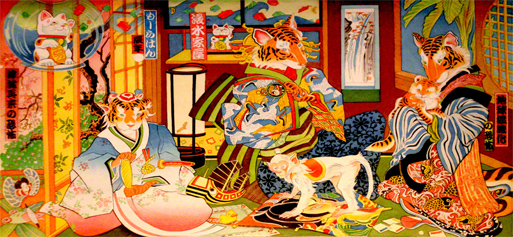Press / Signal Tribune

Inspired by 19th-century Japanese woodblock prints, artist often casts animals as protagonists
Brandy Soto
Signal Tribune
You could say that art has always been in Moira Hahn's life. Her father's parents met each other in a landscape painting class, and their own daughters went on to become artists themselves. So, it is no surprise that Hahn would develop a creative streak from a young age.
She says that she can't remember a time in her life when she wasn't drawing. "I'm told I drew a lot when I was 2 to 3 years old," she recalls. "A visiting great-aunt remembered me doing that, not my immediate family–it must have been a constant 'tic' that they'd long since stopped noticing. I clearly remember drawing pictures for hours, years before I could read, write or ride a bike."
Hahn says she knew she wanted to pursue a life in art since she was 5 years old and she did just that. She earned bachelor's and master's degrees in art, attended additional classes at various art schools and participated in a five-year apprenticeship with a Japanese artist. Her studies involved expansive traveling in the U.S., Japan and Europe.
She creates bold, colorful drawings and prints often inspired by Asian and Western artwork. Artists that have influenced her work include, but are not limited to Shibata Zeshin, Daniel du Plessis, Utagawa Kuniyoshi and Barbara A. Thomason.
"The works best recognized as mine, within the past decade, have stylistic roots in classical Japanese art history," she says. "Those paintings resemble mid-19th century Japanese woodblock prints, and the protagonists are animal rather than human 'actors.' Many of the situations represented have more to do with 21st century social and political commentary in California than Kabuki plays in Edo Period Japan. Issues such as global warming, predatory species (for example, pet cats vs. wild birds) and disappearing habitat for endangered wildlife are more likely to take center stage than love poetry by serene and elegant Imperial courtesans, or samurai war epics."

"Under Water World" (2012), watercolor
Hahn has experimented with several different mediums, but she says there is one medium of which she is especially fond.
"I've painted in oil, acrylic and gouache, and worked in other media including sculpture, electronics, printmaking and mixed media," she says. "But so far, I always come back to watercolor."
Because she uses watercolor, creating the pieces is often a tedious process for her.
"There's a lot of planning involved," she explains. "Unlike with oil or acrylic painting, one cannot erase or make changes once the painting is underway. The technique and style are very specific, controlled and tightly rendered. So this work is far from 'ad lib' or freestyle, but rather, intensely and methodically planned."
Hahn enjoys hearing others' interpretations of her art and says it is like "buried treasure."
"I love to eavesdrop anonymously on docent- or instructorled tours of my art in museums and colleges," she confesses. "Sometimes very obvious 'reads' of the image under discussion eluded my consciousness while I made the art, but once I hear a comment, I instantly know that the viewer is right."
She remembers a time when a college instructor had asked her students what they thought one of Hahn's paintings meant. One male student said, "I don't want to know what it means. It's completely mysterious, I enjoy it as such, and hearing what the artist intended would ruin that pleasure." Hahn says she agrees with his philosophy.
"[My pieces] are not political cartoons or book illustrations, but fine art," she says. "So my wish is that each person's interpretation is individual, personal and revelatory."
Hahn will be featured in the Mid-City Studio Tour in Long Beach on Saturday, June 1 and Sunday, June 2. She will share the studio space with her friend and "excellent fellow painter" Daniel du Plessis.
|

